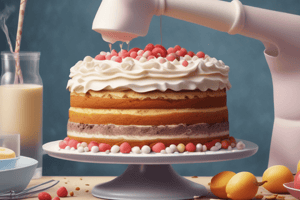Podcast
Questions and Answers
What is the primary goal of mixing cake batter?
What is the primary goal of mixing cake batter?
- To incorporate air cells only
- To develop the proper texture only
- To cream fat and sugar together
- To combine ingredients uniformly and incorporate air cells (correct)
What type of cake relies primarily on creamed fat?
What type of cake relies primarily on creamed fat?
- Genoise
- Spongecake
- Butter cake (correct)
- Angel food cake
What is an example of a cake that combines creaming and egg foam mixing techniques?
What is an example of a cake that combines creaming and egg foam mixing techniques?
- Brownie
- Poundcake
- Genoise
- Sacher Torte (correct)
What are the characteristics of a good high-fat cake?
What are the characteristics of a good high-fat cake?
What type of cakes usually need the assistance of a chemical leavener?
What type of cakes usually need the assistance of a chemical leavener?
What is the primary difference between butter cakes and high-ratio cakes?
What is the primary difference between butter cakes and high-ratio cakes?
What type of cakes are popular for birthdays and special occasions?
What type of cakes are popular for birthdays and special occasions?
What is the primary function of air cells in cake batter?
What is the primary function of air cells in cake batter?
What is the characteristic of high-fat cakes that makes them unsuitable for certain uses?
What is the characteristic of high-fat cakes that makes them unsuitable for certain uses?
What is the purpose of creaming fat in cake making?
What is the purpose of creaming fat in cake making?
What happens when eggs are mixed into the creamed fat?
What happens when eggs are mixed into the creamed fat?
Why is additional liquid required when substituting shortening for butter in a creaming-method cake?
Why is additional liquid required when substituting shortening for butter in a creaming-method cake?
What is the ideal temperature for creaming fat in cake making?
What is the ideal temperature for creaming fat in cake making?
Why is it important to add eggs slowly to the creamed fat and sugar?
Why is it important to add eggs slowly to the creamed fat and sugar?
What is the consequence of poorly emulsifying the ingredients in a butter cake?
What is the consequence of poorly emulsifying the ingredients in a butter cake?
Why is flour added gradually to the cake batter, alternating with the liquid?
Why is flour added gradually to the cake batter, alternating with the liquid?
Flashcards are hidden until you start studying
Study Notes
Mixing Methods
- The goals of mixing cake batter are to combine ingredients uniformly, incorporate air cells, and develop the proper texture.
Types of Cakes
- Mixing methods can be divided into two categories: high fat (structured primarily on creamed fat) and egg foam (structured primarily on whipped eggs).
- High fat cakes include butter cakes and high-ratio cakes.
- Egg foam cakes include genoise, spongecakes, angel food cakes, and chiffon cakes.
Creamed Fat Cakes
- Creamed-fat cakes include most popular American-style cakes, such as poundcakes, layer cakes, coffeecakes, and brownies.
- These cakes are based on high-fat formulas, most containing chemical leaveners.
- A good high-fat cake has a fine grain, cells of uniform size, and a crumb that is moist rather than crumbly.
- Crusts should be thin and tender.
- Creamed-fat cakes can be divided into two classes: butter cakes and high-ratio cakes.
Butter Cakes
- Butter cakes, also known as creaming-method cakes, begin with softened butter or shortening creamed to incorporate air cells.
- These cakes usually need the assistance of a chemical leavener to achieve the proper rise.
- Modern-day butter cakes are made with the creaming method and are tender yet sturdy enough to handle rich buttercreams or fillings.
- High-fat cakes are too soft and delicate to use for roll cakes or to slice into extremely thin layers.
Creaming Method
- Creaming fat mechanically leavens the cake and creates a mixture in which fats and liquid are suspended.
- Air cells are trapped in the fat, lightening the mixture.
- As eggs are mixed into the creamed fat, the mixture emulsifies, allowing fats and liquids to be held in suspension.
- Creaming-method cake formulas specify whether to use butter or shortening.
- When substituting butter for shortening, additional liquid must be added to replace the liquid lost.
- Butter cannot support the same quantity of sugar, liquids, and flour as shortening due to its 15% moisture content.
Tips for Mixing
- Fat should be creamed at low to moderate speeds to prevent raising its temperature.
- All ingredients should be at room temperature (70°F/21°C) for effective creaming.
- Eggs should be added slowly to maintain the emulsion formed when the sugar and butter were creamed.
- Flour should be added gradually, alternating with the liquid, to prevent overdevelopment of gluten.
Studying That Suits You
Use AI to generate personalized quizzes and flashcards to suit your learning preferences.




